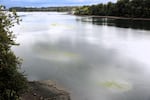
Authorities looked into the green plants that have bloomed along the Willamette River through downtown Portland on Oct. 16, 2023.
Kristian Foden-Vencil / OPB
Authorities spent much of Monday looking into the unusual appearance of long, green strips in the Willamette River over the last few days near downtown Portland, only to find it wasn’t potentially harmful algae.
The potentially toxic blooms usually get washed away with fall rains and cooler temperatures but have recently become a more frequent problem at the end of summer, when water temperatures rise, water flow is slow or stagnant and there are lots of nutrients in rivers. Nutrients can come from various sources, including fertilizers and pet waste.
Oregon Department of Environmental Quality’s Susan Mills said agency staff were on the river Monday monitoring the scummy substance, but found they were likely harmless plants. She told The Oregonian/OregonLive the plants were likely sent downriver by rain moving through the region.
Portions of the Willamette River were under an algae warning this summer.
It is not easy to tell if a bloom is harmful by appearance alone, which led to initial caution. Toxic algae produces cyanobacteria that can harm people and animals. Authorities initially warned people to be careful with their pets near the river because they are at particular risk from drinking water that contains harmful plant life.
“It is a bit unusual to see any cyanobacteria or harmful algal blooms at this time of year,” Mills said before the plants in the river were determined safe. “But ... we’re seeing a lot of things that are unusual as climate change progresses.”

Officials thought initially that green streaks of plant-like matter that appeared in the Willamette River bloom could be harmful algae or cyanobacteria. They were ultimately deemed harmless.
Kristian Foden-Vencil / OPB
